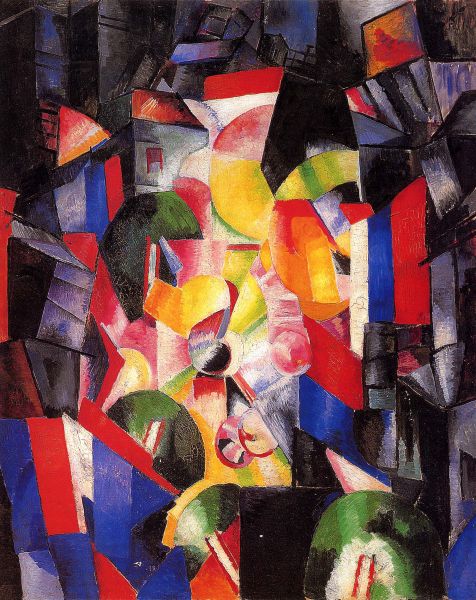|
|
City at Night. 1913

Exter Alexandra,
Oil on canvas
88 x 71
State Russian Museum
Annotation
Alexandra Exter’s career was filled with tireless searches and experiments, coinciding to a large extent with what many of her contemporaries were doing in art. Study in Paris and meetings with Pablo Picasso, Georges Braque, Guillaume Apollinaire, Filippo Tommaso Marinetti and Giovanni Papini on the one hand, and the obvious influence of Ukrainian folk art on the other, defined the Cubo-Futurist. Constructivist and colourist bases of her abstract works. Despite all the apparent chaos, Alexandra Exter's non-objective compositions and colour constructions are harsh and dynamic. They are precisely ordered and full of inner energy. The acute-angled planes seem to stand on end, cutting and slashing one another.
The rhythmic structure is supplemented by the sharp contrasts of the colourlit. Torn by internal contradiction, the energetic field of force represents a sort of infinity incalculable by mundane measures. Some special laws of equilibrium and harmony dominate here.
Author's Biography
Exter Alexandra
Exter, Alexandra Alexandrovna (1882, Belostok (Hrodno Gubernia) — 1949, Fontenay-aux-Roses (France))
Painter, graphic artist, theatrical designer, book illustrator, created “manuscript” books and designed clothes. Studied at the Kiev School of Art (1901– 1903, 1906–1908, not enrolled). Lived in Kiev, Moscow and Paris (periodically from 1907 to 1924), where she had a studio. Personally acquainted with Pablo Picasso, Georges Braque, Guillaume Apollinaire and Max Jacob and the Italian Futurists Ardengo Soffici, Filippo Tommaso Marinetti and Giovanni Papini. Associated with such members of the Russian artistic colony in Paris as Nathan Altman, Marc Chagall, David Sterenberg and Vladimir Baranoff- Rossiné. Met Alexander Tairov (1915) and designed for the Chamber Theatre in Moscow (1915). Contributed to exhibitions (from 1908) including Link (1908), Wreath of Stefanos (1909); Union of Youth (1910 and 1913–1914), Knave of Diamonds (1910–1914, 1916–1917), No. 4: Futurists, Rayists, Primitives (1914), Exposition des Arts Décoratifs (Paris, 1925, gold medal). First solo exhibition at Sturm Galerie (1927, Berlin). Taught at VKhUTEMAS (Moscow, 1921–1922) and Fernand Léger’s Académie d’Art Moderne in Paris (1925–1930). Helped to design the Soviet pavilion for the XIV Esposizione Internazionale d’Arte in Venice (1924). Settled in the suburb of Fontenay-aux-Roses (1928).

